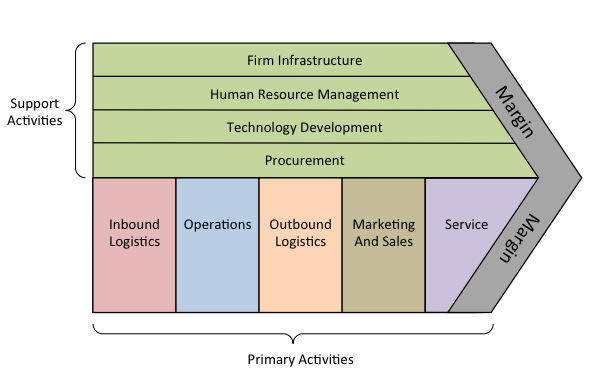If you want to increase your profits, Porter’s Value Chain can identify where your small business creates value.
In his book ‘Competitive Advantage’, Michael Porter proposed the Value Chain as a way of understanding that competitive advantage is not created by a business but by each of the distinct value adding activities that it performs in designing, producing, marketing, delivering and supporting a product.
The value chain is the sequence of activities that a business performs in order to create and deliver a valuable product.
The model considers each activity as having inputs, transformation processes and outputs. Resources are consumed by each activity as value is created. The value created by the business is the sum of the value created by each activity and it is this value that creates the profit, or margin, of the business.
Porter’s Value Chain
Porter’s Value Chain is split into primary activities, support activities and margin.
Primary Activities
Primary activities are those processes that are directly involved with producing and supporting a delivered product or service.
- Inbound logistics – the activities dealing with how inputs are received, stored and distributed to the production process.
- Operations – the activities that relate to transforming inputs into a product or service.
- Outbound logistics – the activities that deal with collection, storage and distribution of the product or service.
- Marketing and Sales – the activities associated with informing the customer about the product and enabling the purchase by the customer.
- Service – the processes and activities that support the ongoing value of the product to the customer after it has been purchased.
Support Activities
Support activities enable each of the primary activities to take place whilst not being directly involved with producing the product or service.
- Procurement – the activities that relate to the purchasing of resources needed by the organisation to operate.
- Human resource management – the activities relating to the recruitment, training and ongoing management of personnel.
- Technological development – the activities concerned with managing information and the development and protection of the business’s knowledge base.
- Infrastructure – the activities and functions that support the business itself e.g. administrative, accounting, legal and general management.
Margin
The profit margin of the business is the value created and delivered to the customer minus the cost of creating that value.
How to use Porter’s Value Chain
Follow these steps to apply the model to your small business.
- Identify the Primary Activities and Support Activities within your business.
- Identify the processes and tasks within each activity.
- Assess the processes and tasks to establish where value is being added and where value is not being added.
- Evaluate how well the main activities interact together to determine whether these ‘linkages’ are adding value or not.
- Take action to maximize value adding activities across the system and to eliminate activities adding no value.
Summary
By examining the Value Chain of your small business you can identify your value adding activities, strengthen your competitive advantage, maximize your profits and set your business free.
© Business Set Free Ltd 2013
This is just one of many articles that you can find at BusinessSetFree.com or click to subscribe to our free e-newsletter.







